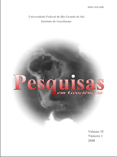Geochemical aspects of the silicification in sedimentary rocks in Rio Grande do Sul, Brazil
DOI:
https://doi.org/10.22456/1807-9806.19543Keywords:
silcrete, silicification, silicified sandstones.Abstract
Some exposures of silicified sedimentary rocks and duricrusts occur in the central Depressão Periférica along the edge of the Paraná Basin in Rio Grande do Sul State, in southern part of Brazil. These silicified materials were firstly studied in the petrographic aspects by Silvério da Silva & Menegotto (2002). This paper presents geochemical results of the analysis on samples of sedimentary rocks and silica duricrusts collected in two profiles (Santa Maria and Cachoeira do Sul). The relationships between the sedimentary rocks and the duricrusts, as well their probable provenance and genesis, are discussed. Silicification occurs as lenses, concretions, nodules and pedotubules, in the Mesozoic sedimentary rocks of these profiles. Micro quartz predominates and forms the most part of the matrix. Fibrous chalcedony and mega quartz were present in minor amounts filling vughs. Three types of silicification were recognized: silcretes (SiO2>87%), silica rich concretions (SiO2 from 76.10 % to 86.76% SiO2) and sedimentary rocks with few silica cement. Gresen′s mass balance is presented to point out the gain of SiO2. The silica source is related to weathering processes of the minerals of the sedimentary rock and added to the groundwater.



